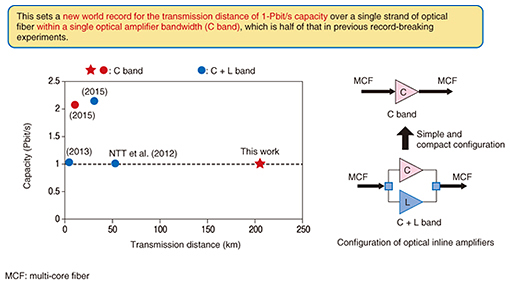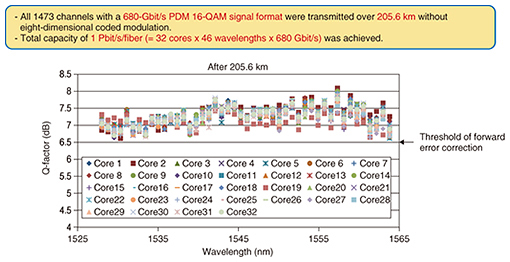 |
|||||||||||||
|
|
|||||||||||||
|
Short Reports Vol. 15, No. 6, pp. 57–59, June 2017. https://doi.org/10.53829/ntr201706sr1 One-petabit-per-second Fiber Transmission over a Record Distance of 200 km—Paving the Way to Realizing 1000-km Inline Optical Amplified Transmission Systems within C Band Only1. IntroductionNTT has demonstrated ultralarge capacity inline optical amplified transmission of 1 petabit (1000 terabits) per second (Pbit/s) over a 205.6-km length of 32-core optical fiber in collaboration with the Technical University of Denmark, Fujikura Ltd., Hokkaido University, the University of Southampton, and Coriant GmbH. This sets a new world record for the transmission distance of 1-Pbit/s capacity over a single strand of optical fiber within a single optical amplifier bandwidth (C band), which is half the bandwidth used in the previous experiment (Fig. 1). The present achievement indicates that the transmission of 1 Pbit/s—a capacity equivalent to sending 5000 high-definition television videos each two hours long in a single second—is potentially possible over 1000 km, which is approximately the distance between major cities in both Japan and Europe.
Part of this research utilized results from the EU-Japan coordinated research and development project on Scalable And Flexible optical Architecture for Reconfigurable Infrastructure (SAFARI) [1] commissioned by the Ministry of Internal Affairs and Communications of Japan and EC Horizon 2020. 2. Experiment and resultsThe use of 32-core multi-core fiber (MCF), which we have successfully prototyped for a long length of over 50 km [2], a fan-in/fan-out (FI/FO) device to couple light into the MCF, and new digital coherent optical transmission technology made it possible to achieve the high-capacity optical transmission rate of 1 Pbit/s. We accomplished this by exploiting dense space and wavelength division multiplexing (DSDM and DWDM) over long distances. The 32-core MCF used in the experiment utilized a new arrangement of cores that greatly reduces inter-core light leakage that otherwise degrades performance [2]. In addition, we used the wave properties of light (phase and polarization) to apply multi-dimensional coding to polarization division multiplexed 16-quadrature amplitude modulation (PDM 16-QAM) digital coherent technology to improve the long-distance transmission performance in each core. The experimental results are shown in Fig. 2. We achieved 31.3-Tbit/s capacity per core (= 680 Gbit/s per wavelength x 46 wavelength channels), and using the 32-core MCF, we recirculated and amplified the signals over four spans of the 51.4-km fiber, demonstrating that signal transmission of an aggregate 1-Pbit/s capacity was possible over 205.6 km.
The Q-factor indicates the transmission quality of the PDM 16-QAM signals. Because the Q-factor was uniform, it showed that high quality transmission with small variations between cores and low error was possible. In 2012, we reported on an experiment in which we achieved a world-first 1-Pbit/s capacity over 52.4 km [3]. In comparison, these new results demonstrate a distance about four times longer at 205.6 km, which is the world’s longest distance for over petabit-per-second capacity transmission. Moreover, by applying a digital signal processing technique called multi-dimensional coded modulation, the capacity per wavelength is reduced by 25% to 510 Gbit/s. Nevertheless, we demonstrated that the transmission distance can be increased to over 1000 km. As a result, with one optical fiber, we showed that there is a possibility for ultrahigh capacity equivalent to 0.75 Pbit/s using just the 5 THz bandwidth of the C band, and 1.5 Pbit/s using the 10 THz bandwidth provided by the combined C and L bands, with a potential transmission distance over 1000 km. 3. Technological features and rolesHere, we describe the technology that was applied to achieve the 1-Pbit/s transmission over a record distance. 3.1 Thirty-two-core MCF transmission lineThe MCF we used in this experiment was jointly designed and prototyped by the Technical University of Denmark, Fujikura, and Hokkaido University. The fiber has a new structure (single-mode heterogeneous-core MCF) with 32 cores incorporating several types of cores, each with different properties [2]. The characteristic of this fiber is that two kinds of cores with slightly different refractive indices are arranged in a square lattice pattern. With this structure, even if the number of cores is increased to 30 or more, the crosstalk between adjacent cores can be greatly reduced [2], making it possible to realize long-distance DSDM transmission [4]. NTT and Coriant evaluated the long distance characteristics of the 51.4-km MCF transmission line with the 32-core MCF and FI/FO devices prototyped by Fujikura, the University of Southampton, and NTT. As a result, we confirmed that all cores had low crosstalk and low loss characteristics over the entire C band, which is a requirement for a 32-core MCF transmission line suitable for transmission over a 1000-km distance. 3.2 Multi-dimensional coded 16-QAM techniqueIn recent large-capacity optical communications, instead of the intensity modulation signal transmitted using binary states of either ON or OFF, a highly efficient PDM-QAM digital coherent signal has been used that realizes a large number of signal states created by using the wave properties (phase and polarization) of light. Such multi-level QAM signals can achieve a highly efficient ultrahigh speed optical signal by associating a plurality of bits of digital signals with a plurality of optical signal states encoded using the phase and polarization of light. However, the drawback is that when we increase transmission efficiency by increasing the number of multi-levels, the transmission distance sharply decreases. In addition, signal quality degrades by the crosstalk that arises in MCF transmission. In this case, NTT reduced the number of multi-levels of the QAM signal from 32 in the conventional report [3] to 16 and applied a wideband digital-analog conversion technique [5] to the digital coherent signal using highly efficient error correction coding. As a result, we successfully transmitted a capacity of 680 Gbit/s per wavelength (1 Pbit/s per fiber) over a 205.6-km distance, the longest distance for petabit-per-second capacity transmission. Furthermore, by applying the eight-dimensional encoded 16-QAM technique [6] and by improving the allocation method of the digital signal and the optical signal state, the transmission quality can improve compared with the normal QAM code. With the same 16-level QAM, the transmission rate will be reduced to 510 Gbit/s per wavelength, but by doing this, we showed that it has the potential to extend the transmission distance to possibly over 1000 km. References
For InquiriesPublic Relations, NTT Science and Core Technology Laboratory Group Email: a-info@lab.ntt.co.jp |
|||||||||||||


